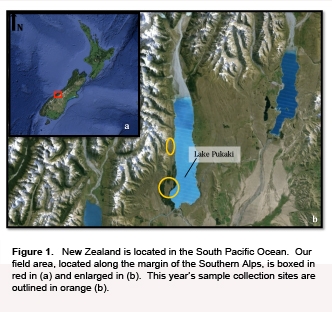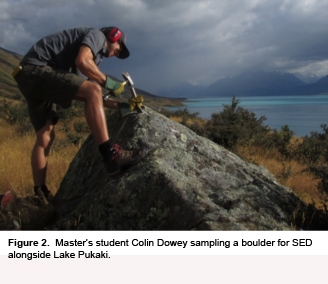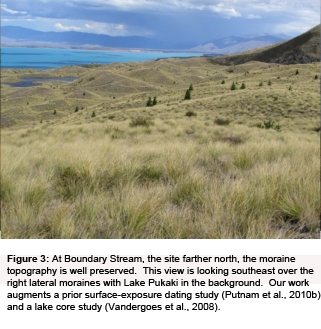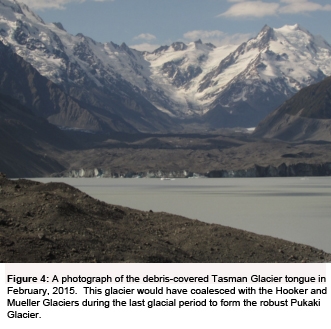A Beryllium-10 Chronology of the former Pukaki Glacier, New Zealand: Uncovering the Structure of the Last Termination
A Beryllium-10 Chronology of the former Pukaki Glacier, New Zealand: Uncovering the Structure of the Last Termination
Field Team Members: Courtney King1,2, Colin Dowey1,2, Dr. George Denton1,2, Dr. Aaron Putnam3, and David Barrell4
1. Climate Change Institute, University of Maine; 2. Department of Earth and Climate Sciences, University of Maine; 3. Lamont-Doherty Earth Observatory, Columbia University; 4.GNS Science, New Zealand
January 19, 2015 – February 18, 2015
Funding Support: National Science Foundation, Comer Science and Education Foundation, and the Quesada Family Foundation
Background
The termination of the last ice age is the largest abrupt climate change of the last 100,000 years, and yet its origin remains enigmatic. Recent work has led to the hypothesis that terminations are characterized by massive outbursts of icebergs and freshwater in the North Atlantic that lead to reduced Atlantic Meridional Overturning Circulation and spread of sea ice (Broecker and Denton, 1990). This northern hemisphere cooling is thought to cause southward shift of the major atmospheric and oceanic fronts, leading to warming in the mid-to-high latitudes of the southern hemisphere (SH) (Denton et al., 2010). Testing this hypothesis and other proposed drivers of ice-age terminations requires detailed and well-dated paleoclimate records through the end of the last ice age. When coupled with glaciological modelling, glacier records yield precise information on changing climate conditions at the periphery of the Southern Ocean during the last termination. For the New Zealand study, we will use glacial geologic mapping and 10Be surface exposure-age dating (SED) to produce a detailed chronology of the onset of the last termination as recorded by the former Pukaki Glacier in the Southern Alps of New Zealand.
With this climate record, we can compare the character of the last termination in New Zealand to the latest Antarctic temperature record from the WAIS-Divide Ice Core, in order to assess the temperature change variance over time at both the northern and southern margins of the Southern Ocean. We will use this comparison to assess the reaction of the Antarctic Ice Sheet to the warming of the last termination (this work is explained in my other two field reports on Hatherton and Darwin Glaciers, Antarctica).
Field Work
In January, we traveled from Christchurch to Twizel, a town southwest of Lake Pukaki. From our base in Twizel, we spent a month in the region west of Lake Pukaki mapping the glacial landforms deposited by the former Pukaki Glacier. The mapping provides context for the rock samples we collected for surface exposure-age dating. This region of the Southern Alps has the best-preserved moraine topography on the South Island of New Zealand (Figure 1). The area is familiar to UMaine researchers – many previous graduate students from UMaine have also performed fieldwork along the margins of Lake Pukaki studying various stages of the ice-age cycles. For this field season, we spent a month in the field collecting rock samples along the right lateral moraines deposited by the former Pukaki Glacier (Figures 2 and 3).
Future Work
The rock samples collected for the SED method were sent to the Lamont-Doherty Earth Observatory where they will undergo chemical analysis. Surface exposure-age dating is a popular method used to date glacial erratics because it involves counting the number of atoms of 10Be, an isotope of the element Beryllium, which is produced when cosmogenic rays react with quartz (SiO2) molecules in the rock. As the glacier transports the boulders, erosion removes the outer layer of the rocks, essentially eliminating the accumulated 10Be and resetting the clock that measures how long it’s been exposed to the cosmic rays. The clock begins once the erratics are deposited by the glacial ice because they begin accumulating the 10Be isotope. Chemically processing a sample-set takes several months. Once the 10Be is isolated, the samples are analyzed at the Center for Accelerator Mass Spectrometry facility at Lawrence Livermore National Laboratory. In addition to the rock sample analyses, we will digitize the field maps using ArcGIS software to add to the compilation of geomorphologic maps produced for this region (eg. Barrell et al., 2013; Doughty et al., 2015, 2013; Kaplan et al., 2013; Putnam et al., 2012, 2010a, 2010b).
References
Barrell, D.J.A., Anderson, B.G., Denton, G.H., 2011. Glacial Geomorphology of the central South Island, New Zealand. GNS Science Monograph 27. Lower Hutt, GNS Science. 1 map (5 sheets) + 81p.
Broecker, W.S., Denton, G.H., 1990. The Role of Ocean-Atmosphere reorganizations in glacial cycles. Quat. Sci. Rev. 9, 305–341.
Denton, G.H., Anderson, R.F., Toggweiler, J.R., Edwards, R.L., Schaefer, J.M., Putnam, a E., 2010. The last glacial termination. Science 328, 1652–1656. doi:10.1126/science.1184119
Doughty, A.M., Anderson, B.M., Mackintosh, A.N., Kaplan, M.R., Vandergoes, M.J., Barrell, D.J. a., Denton, G.H., Schaefer, J.M., Chinn, T.J.H., Putnam, A.E., 2013. Evaluation of Lateglacial temperatures in the Southern Alps of New Zealand based on glacier modelling at Irishman Stream, Ben Ohau Range. Quat. Sci. Rev. 74, 160–169. doi:10.1016/j.quascirev.2012.09.013
Doughty, A.M., Schaefer, J.M., Putnam, A.E., Denton, G.H., Kaplan, M.R., Barrell, D.J.A., Andersen, B.G., Kelley, S.E., Finkel, R.C., Schwartz, R., 2015. Mismatch of glacier extent and summer insolation in Southern Hemisphere mid-latitudes. Geology 43, 407–410. doi:10.1130/G36477.1
Kaplan, M.R., Schaefer, J.M., Denton, G.H., Doughty, A.M., Barrell, D.J.A., Chinn, T.J.H., Putnam, A.E., Andersen, B.G., Mackintosh, A., Finkel, R.C., Schwartz, R., Anderson, B., 2013. The anatomy of long-term warming since 15 ka in New Zealand based on net glacier snowline rise. Geology 41, 887–890. doi:10.1130/G34288.1
Putnam, A.E., Denton, G.H., Schaefer, J.M., Barrell, D.J. a., Andersen, B.G., Finkel, R.C., Schwartz, R., Doughty, A.M., Kaplan, M.R., Schlüchter, C., 2010a. Glacier advance in southern middle-latitudes during the Antarctic Cold Reversal. Nat. Geosci. 3, 700–704. doi:10.1038/ngeo962
Putnam, A.E., Schaefer, J.M., Barrell, D.J.A., Vandergoes, M., Denton, G.H., Kaplan, M.R., Finkel, R.C., Schwartz, R., Goehring, B.M.M., Kelley, S.E., 2010b. In situ cosmogenic 10Be production-rate calibration from the Southern Alps, New Zealand. Quat. Geochronol. 5, 392–409. doi:10.1016/j.quageo.2009.12.001
Putnam, A.E., Schaefer, J.M., Denton, G.H., Barrell, D.J. a., Finkel, R.C., Andersen, B.G., Schwartz, R., Chinn, T.J.H., Doughty, A.M., 2012. Regional climate control of glaciers in New Zealand and Europe during the pre-industrial Holocene. Nat. Geosci. 5, 627–630. doi:10.1038/ngeo1548
Vandergoes, M.J., Dieffenbacher-Krall, A.C., Newnham, R.M., Denton, G.H., Blaauw, M., 2008. Cooling and changing seasonality in the Southern Alps, New Zealand during the Antarctic Cold Reversal. Quat. Sci. Rev. 27, 589–601. doi:10.1016/j.quascirev.2007.11.015





